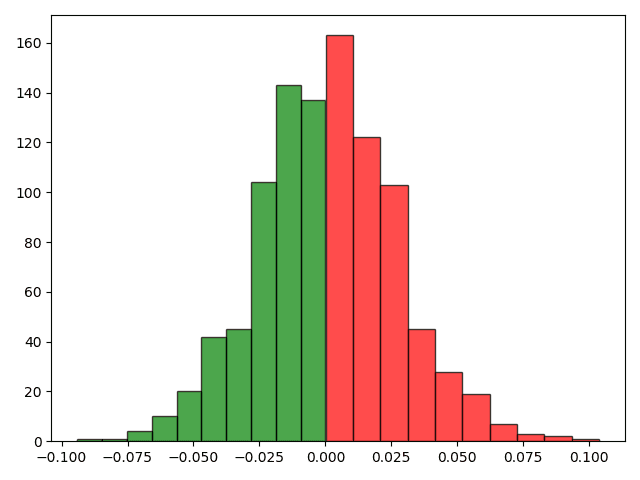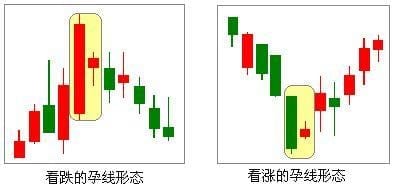
上一篇文章《Python 量化投资实战教程(7)—孕线真的有用吗?》中我们讲到了孕线的形态和其基本的量化规则。

不过,当时只是基于一支股票对这个策略进行回测,数据量过少,其结果并不具有参考性。
今天,我们将在A股中抽取1000只股票,计算这些股票在2010年1月1日至2020年5月10日采用孕线策略的收益率。
本文完整源代码和数据均在开源代码仓库中:
https://github.com/Ckend/pythondict-quant
1.准备
开始之前,你要确保Python和pip已经成功安装在电脑上噢,如果没有,请访问这篇文章:超详细Python安装指南 进行安装。如果你用Python的目的是数据分析,可以直接安装Anaconda:Python数据分析与挖掘好帮手—Anaconda
Windows环境下打开Cmd(开始—运行—CMD),苹果系统环境下请打开Terminal(command+空格输入Terminal),准备开始输入命令安装依赖。
当然,我更推荐大家用VSCode编辑器,把本文代码Copy下来,在编辑器下方的终端运行命令安装依赖模块,多舒服的一件事啊:Python 编程的最好搭档—VSCode 详细指南。
在终端输入以下命令安装我们所需要的依赖模块:
pip install backtrader pip install numpy pip install matplotlib
看到 Successfully installed xxx 则说明安装成功。
2.策略
买入卖出策略与上篇文章一致:
买入:符合孕线形态时,买入。
卖出:涨10%或跌10%。

策略核心代码如下:
# Python 实用宝典
def next(self):
self.log("Close, %.2f" % self.dataclose[0])
if self.order:
return
if not self.position:
# condition1 = self.sma20[0] > self.dataclose[0]
if self.dataclose[-1] < self.dataopen[-1]:
harami = (
self.datahigh[0] < self.dataopen[-1]
and self.datalow[0] > self.dataclose[-1]
)
else:
harami = (
self.datahigh[0] < self.dataclose[-1]
and self.datalow[0] > self.dataopen[-1]
)
if harami:
self.log("BUY CREATE, %.2f" % self.dataclose[0])
self.order = self.buy()
else:
condition = (self.dataclose[0] - self.bar_executed_close) / self.dataclose[0]
if condition > 0.1 or condition < -0.1:
self.log("SELL CREATE, %.2f" % self.dataclose[0])
self.order = self.sell()除此之外,在交易完成时要记录利润率:
def notify_order(self, order):
if order.status in [order.Submitted, order.Accepted]:
return
if order.status in [order.Completed]:
if order.isbuy():
self.log(
"BUY EXECUTED, Price: %.2f, Cost: %.2f, Comm %.2f"
% (order.executed.price, order.executed.value, order.executed.comm)
)
self.buyprice = order.executed.price
self.buycomm = order.executed.comm
self.bar_executed_close = self.dataclose[0]
else:
self.log(
"SELL EXECUTED, Price: %.2f, Cost: %.2f, Comm %.2f"
% (order.executed.price, order.executed.value, order.executed.comm)
)
temp = float(order.executed.price - self.buyprice)/float(self.buyprice)
self.params.profits.append(temp)
self.bar_executed = len(self)
elif order.status in [order.Canceled, order.Margin, order.Rejected]:
self.log("Order Canceled/Margin/Rejected")
self.order = None最后,分析每支股票的利润率,求得平均值并绘图:
# 计算
pos = []
neg = []
for data in result:
res = np.mean(result[data])
if res > 0:
pos.append(res)
else:
neg.append(res)
print(f"正收益数量: {len(pos)}, 负收益数量:{len(neg)}")
plt.hist(pos, facecolor="red", edgecolor="black", alpha=0.7)
plt.hist(neg, facecolor="green", edgecolor="black", alpha=0.7)
plt.show()
最终算得正收益数量:493,负收益数量:507,利润分布图如下:

3.总结
针对A股1000支股票10年运行轨迹的回测结果显示,孕线策略收益可能性略低于50%,并不是一个靠谱的通用策略。
也许该策略特别符合某些股票,但是大家请注意,这样的“符合”是基于小样本概率的,这样想你就明白了:【抛五次硬币,五次都朝上的概率是不小的】,因此三千只股票中出现几只这样的股票也非常正常。
不过,许多策略都不能单独使用,我们这个例子中也只是做了一种最简单的回测,如果你有兴趣,可以改造我们的代码,将你自己的想法加入到该策略中,并尝试回测,看看效果如何。
欢迎在公众号后台回复:加群,回答相应红字验证信息,进入互助群交流。
我们的文章到此就结束啦,如果你喜欢今天的Python 实战教程,请持续关注Python实用宝典。
原创不易,希望你能在下面点个赞和在看支持我继续创作,谢谢!
Python实用宝典 (pythondict.com)
不只是一个宝典
欢迎关注公众号:Python实用宝典


评论(0)